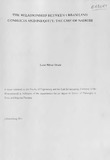The relationship between urban land conflicts and inequity: the case of Nairobi
Abstract
This thesis sets out to deepen our understanding of the linkages between urban dynamics that influence access, use and ownership of land in developing countries. This is because land scarcity, increased competition for land and inequitable allocation of land in African cities and the mediation of power, politics, ethnicity and corruption, coupled with inequitable access to land, often contribute to conflicts over land. The thesis explores this reality through the case of Nairobi. Two arguments premise this thesis; one argument posits that urban land conflicts persisting in Africa are largely resulting from land co modification which is not in conformity with existing African land relations. The second argument is that the persistence of urban inequity well beyond colonialism into the present time has produced reinforced inequity in access to and ownership, thereby producing patronage, ethnic and corrupt approaches to land management and allocation processes. These have invariably led land conflicts. As such the study sought to answer one major question that could help establish the links between land scarcity, ethnicity, corruption and conflicts. The question is: what is the relationship between land conflicts and inequity? The thesis aimed to explain the linkage between land commodification processes and inequity, exploring the nature, causes, extent, dimensions and dynamics of land conflicts. It further sought to explore the linkage of the existing institutional arrangements to urban land conflicts. It anticipated the drawing of conclusions on the linkages between land conflicts, land management, commodification, ethnicity, corruption and political patronage and how these linkages contribute to inequity and, subsequently, land conflicts. The study applied a qualitative case study approach, exploring the relationships between land conflicts and inequity. Four in depth case studies, Tassia, Embakasi Jua Klai, Pipeline and Mathare North, were conducted in Nairobi. The study drew on a combination of theories, including ethnic manipulation, structure and agency, institutional analysis, uneven development, grounded theories and group interest. These helped in the analysis and informed the data collection approaches. In addition, they assisted in the development of appropriate explanations of the dynamics between factors such as ethnicity, corruption, and the market, among others. In drawing conclusions, they were useful in unraveling the relationships between land conflicts and the various mediating factors. The results from this study include the establishment of the fact that urban land conflicts result from social, political and economic factors. The factors are mediated by several factors that are institutional, ethnic and patronage-based. The thesis reveals the linkage between ethnicity and corruption, and the simultaneous relationships between power, corruption, institutions and ethnicity. For the Nairobi case, the study brings to the fore the central role of ethnicity in resource conflicts. It also reveals the dynamic nature of land conflicts, thereby suggesting that land issues are social, economic and political. Addressing land conflicts conclusively requires a careful political process that must also be embedded in the legal systems of the particular country. The study concludes by proposing areas for further study, including ethnicity and land ownership in Kenya’s urban areas; corruption, politics and landlordism in Nairobi; land markets and conflicts in urban areas; the development of appropriate models for urban land management, and the links between land tenure and conflicts over land in urban areas
URI
: http://hdl.handle.net/10539/10966http://erepository.uonbi.ac.ke:8080/xmlui/handle/123456789/18517

